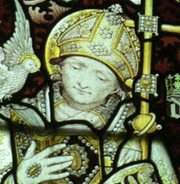Saint David's Day

Celebrated 1 March

St. David as shown in a stained glass window in Jesus College Chapel, Oxford. Photo credit: Casper Gutman
Related Links
More on St. David
| St. Andrew's Day Dates | |
|---|---|
| 2008 | Saturday 1 March |
| 2009 | Sunday 1 March |
| 2010 | Monday 1 March |
| 2011 | Tuesday 1 March |
| 2012 | Thursday 1 March |
Each year Saint David's day is celebrated in Wales and by Welsh families around the world on 1 March in remembrance of his death on 1 March, 589. There are exceptions, however, when celebrations occur at a different time. In 2006, Saint David's Day fell on the same day as Ash Wednesday. Since saints are not celebrated on Ash Wednesday, a day of penitence, Roman Catholics observed Saint David's Day on 28 February in 2006 and the Anglican Church in Wales honored the holiday on 2 March in 2006.
Who is Saint David?
Saint David, known as Dewi Sant in the Welsh language, is the patron Saint of Wales. It is thought that he lived during the sixth century. Saint David became Archbishop of Wales during his life, and was one of the early Saints to spread Christianity among tribes of western Britain. Most of the information about Saint David come from Buchwedd Dewi (Life of David), written by Rhigyfarch in the 11th century. Another book was written in the 12th century by Gerallt Gymro, giving information about Saint David's early life and travels. Both texts were written nearly 500 years after Saint David's death, so it is not known how much the history of his life is legend or fact. Both sources say that he was a monk, abbot, and bishop, who led a frugal life, eating only bread and vegetables, and drinking only water. In fact, he is sometimes known as Dewi Ddyfrwr (David the water drinker) in Welsh.
Early Life
Saint David was born on the coast of southwest Wales, near the present city of Saint David. It is thought that he had aristocratic heritage—born to Sant, the son of Ceredig, who was prince of Ceredigion. Legend says his mother, Non, who was also a saint, was a niece of King Arthur. Saint David was educated by a blind monk, Paulinus, in a monastery, Hen Fynyw. After some years Saint David left the monastery setting out on missionary journeys across Wales, the south and west of England, and Cornwall establishing churches along the way. He founded a very strict monastery at Glyn Rhosyn where the city of Saint David is today. In addition to completing their prayers and masses, the brothers of his monastery also had to feed and cloth visiting pilgrims, the poor, and themselves.
Legend
The most well-known legend of Saint David is that he caused the ground to rise underneath him so he could be seen and heard by all while preaching at Synod of Llanddewibrefi. The story, written by Rhigyfarch, is considered more legend than fact.
Celebrations Today
Saint David's day, as celebrated today, dates back to 1120 when Saint David became Archbishop of Wales. Saint David's day was celebrated as a holy day until the Reformation in the 16th century. Celebrations were revived in the 18th century when the day of his birth, 1 March 589, became a national festival celebrated by schools and cultural societies all over Wales. Saint David's day is celebrated by Welsh families throughout the world with dinners, parties, recitals and concerts. Many people wear a daffodil, Wales's national flower. In 2003, the United States officially recognized Saint David's day as a national day of the Welsh, and the Empire State building was lit up with the colours of the Welsh flag, red, green, and white.
In 2006, a poll was conducted in Wales for Saint David's day, which found that 87% of 1,001 participants wanted 1 March to be a bank holiday, and 65% of people questioned would give up a different bank holiday to ensure this. In 2007, a petition to make Saint David's day a bank holiday was rejected by Prime Minister Tony Blair on the grounds that bank and public holidays in Great Britain do not, by tradition commemorate particular individuals, other than those associated with Christmas and Easter.
The Welsh Tradition
Saint David is a very important figure in Wales, and so 1 March is a day of great celebration there. Each year there is a concert in St. David's Hall, Cardiff, featuring a 1,000-member male voice choir, flown in from all over the world. Children in primary school wear traditional Welsh costumes—the girls don pais a betgwn (a petticoat and overcoat made of Welsh flannel) and a tall beaver hat worn over a white bonnet. The boys wear a flat beaver hat, black breeches, a Welsh flannel waistcoat, and a white shirt with a jabot and wrist frills. Children participate in Welsh dances, folk songs, and poetry. It is custom to eat a bowl of cawl (leek broth) on Saint David's day and wear a leek or daffodil—both national symbols of Wales. In addition, it is tradition to fly the Welsh national flag, Y Ddraig Goch (the red dragon), on houses and public buildings on Saint David's day.
Do the Little Things
It is generally accepted that Saint David died in 589, and many claim he lived over 100 years. His last words were transcribed by Rhgyfarch as "be joyful, and keep your faith and your creed. Do the little things that you have seen me do and heard about. I will walk the path that our father's trod before us." "Do the little things" ("Gwnewch y pethau bychain") has become a well-known saying, and an inspiration to many Welsh people today. Saint David was buried at his monastery, where the cathedral of Saint David stands today.
- Try the St. David Quiz







